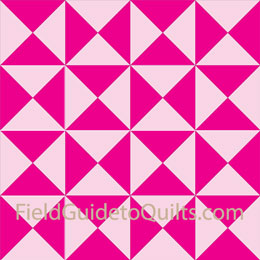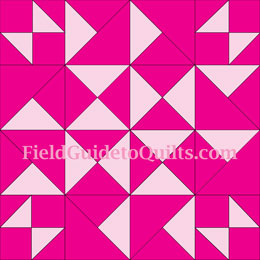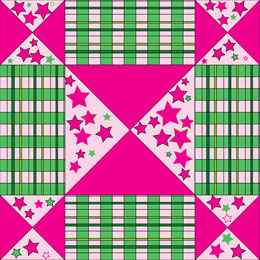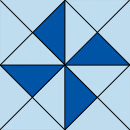A quarter-square triangle is one of four right triangles that make up a square  .
The pieces are joined on the short sides of the triangles.
.
The pieces are joined on the short sides of the triangles.
|
|
 Yankee Puzzle  Old Maid's Puzzle  Clowns  The Jig Jog Puzzle  A Design in Geo-metrics  Mosaic No. 11  Crosses & Losses  Old Maid's Puzzle LAC  Old Maid's Puzzle
Cabot  Double X, No. 1  Double X, No. 2  Double X, No. 3
|
|
Big Dipper/Yankee Puzzle
               
In three colors, you see a turnstile shape
 Yankee Puzzle
Finley, 1929 Yankee Puzzle
Finley, 1929
We'd love to call this block Big Dipper, but then no one would know what block we're talking about. The name most often used for this block is Yankee Puzzle, from Ruth Finley's 1929 book Old Patchwork Quilts.
However, it was first published as Big Dipper in the Ladies Art Company's catalog of 1897 (block #320).
The LAC showed Big Dipper in two colors, just as it is in the Yankee Puzzle block, and it was also in two colors when it appeared as The Hour Glass and The Whirling Blade in the Kansas City Star (1943 and 1944). We've shown a three color version as well. It creates a turnstile — that's what we call this shape: 
With block full of identical triangles, a two-fabric quilt is featureless — it's a one-patch, because there is only one shape.It's an ideal scrap quilt. If you made each block or quarter-square from a different pair of fabrics, all that movement and dimension that you want in a quilt comes back. |
|
Old Maid's Puzzle
 Old Maid's Puzzle
Grandmother Clark Old Maid's Puzzle
Grandmother Clark
1932
Reverse X came first, in 1931, but this block is usually known as Old Maid's Puzzle, from a 1932 Grandmother Clark booklet. (The Star called it Envelope Quilt Pattern in 1943.)
Four Yankee Puzzles equal one Old Maid's Puzzle -- if you turned Yankee Puzzle 90º clockwise. Check the upper left corner of each mockup.
See? Hooray! Now get back to work. |
|
Clown
 Clown
Ladies Art Company Clown
Ladies Art Company
#524,
1928
|
|
The Jig Jog Puzzle
 The Jig Jog Puzzle
Kansas City Star The Jig Jog Puzzle
Kansas City Star
1938                 The Jig Jog Puzzle (as published) The Jig Jog Puzzle (as published)
The bowties make a Sawtooth in a whole quilt, and the rest makes a sort of zig zag that wanders around the star like an inchworm. We've added a three-color version to bring out the Sawtooth. |
|
A Design in Geometrics
 A Design in Geometrics
Kansas City Star A Design in Geometrics
Kansas City Star
1956
|
|
Mosaic No. 11
 Mosaic No. 11
Ladies Art Co.,#339 Mosaic No. 11
Ladies Art Co.,#339
1897
This block goes by two forgettable names: Mosaic No. 11 from the Ladies Art Company (#339, 1897) and Triangles (Nancy Page, 1939), but it makes an interesting quilt. |
|
Crosses & Losses
 Crosses & Losses in an alternative setting Crosses & Losses in an alternative setting
 Crosses & Losses
Ladies Art Co.,#251 Crosses & Losses
Ladies Art Co.,#251
1897  Crosses & Losses Crosses & Losses
Crosses & Losses (Ladies Art Company #251, 1897), took on two more names in the following half century. "Bouncing Betty," according to quilt historian Barbara Brackman, is from Pictorial Review of 1911. The others are from Ruth Finley (Fox & Geese, 1929) and a Grandma Dexter booklet (Hour Glass, ca. 1932).
The whole-quilt setting at far right is from Hall's & Kretsinger's 1935 book The Romance of the Patchwork Quilt in America.
|
|
Old Maid's Puzzle
 Old Maid's Puzzle
Ladies Art Co.,#25 Old Maid's Puzzle
Ladies Art Co.,#25
1897
The LAC named this block and gave it the number 25 in 1897. Carrie Hall recorded the Fox & Geese name in Romance of the Patchwork Quilt in America (1935). Hour Glass is from a Grandma Dexter booklet.
|
|
Old Maid's Puzzle
 Old Maid's Puzzle
Cabot Old Maid's Puzzle
Cabot
1933 |
|
Double X, No, 1
 Double X, No. 1
Ladies Art Co., #76 Double X, No. 1
Ladies Art Co., #76
1897
The LAC introduced this block in 1897, but the usual suspects took a crack at renaming it: Nancy Page (Tennessee, 1934), Farm Journal Quilt Patterns (Nine Square, 1935), Nancy Cabot (Three & Six, 1936), Carrie Hall (Double X, 1935), and the Kansas City Star(The Cat's Cradle, 1960). |
|
Double X, No. 2
 Double X, No. 2
LAC, #77 Double X, No. 2
LAC, #77
1897 |
|
Double X, No. 3
 Double X, No 3
LAC, #78 Double X, No 3
LAC, #78
1897
Compare the whole quilt that alternates pieced and plain blocks for Double X, No. 2 and Double X, No. 3. The pieced blocks in the No. 2 look a bit lost, but the small block in the dominant color makes No. 3 look rather handsome. |
|
 Quarter-square triangles
Quarter-square triangles



 Old Maid's Puzzle
Old Maid's Puzzle























 Clown
Clown Clown
Clown 







































 A Design in Geometrics
A Design in Geometrics














 A Design in Geometrics
A Design in Geometrics A Design in Geometrics
A Design in Geometrics Old Maid's Puzzle
Old Maid's Puzzle























 Old Maid's Puzzle
Old Maid's Puzzle














 Old Maid's Puzzle
Old Maid's Puzzle























 Old Maid's Puzzle
Old Maid's Puzzle Old Maid's Puzzle
Old Maid's Puzzle














 Old Maid's Puzzle
Old Maid's Puzzle














 Old Maid's Puzzle
Old Maid's Puzzle Double X, No. 1
Double X, No. 1 























 Old Maid's Puzzle
Old Maid's Puzzle























 Double X, No. 2
Double X, No. 2 Double X, No. 2
Double X, No. 2 














 Double X, No. 2
Double X, No. 2
 .
The pieces are joined on the short sides of the triangles.
.
The pieces are joined on the short sides of the triangles. 






 The Jig Jog Puzzle
The Jig Jog Puzzle

 Mosaic No. 11
Mosaic No. 11 Crosses & Losses in an alternative setting
Crosses & Losses in an alternative setting Crosses & Losses
Crosses & Losses Crosses & Losses
Crosses & Losses
 becomes this, which looks very different:
becomes this, which looks very different:  . (In practice, quilters leave out unnecessary seams, so it looks more like this
. (In practice, quilters leave out unnecessary seams, so it looks more like this  ). Quarter-square triangles pop up in dozens of blocks, including Ohio Star
). Quarter-square triangles pop up in dozens of blocks, including Ohio Star  and its variations. In rows, quarter-square blocks look like a row of squares on point
and its variations. In rows, quarter-square blocks look like a row of squares on point